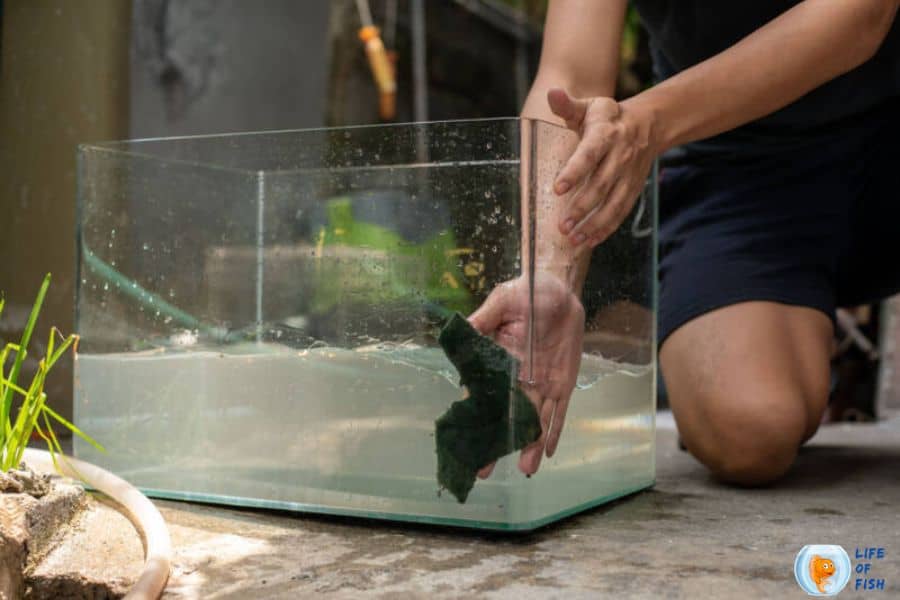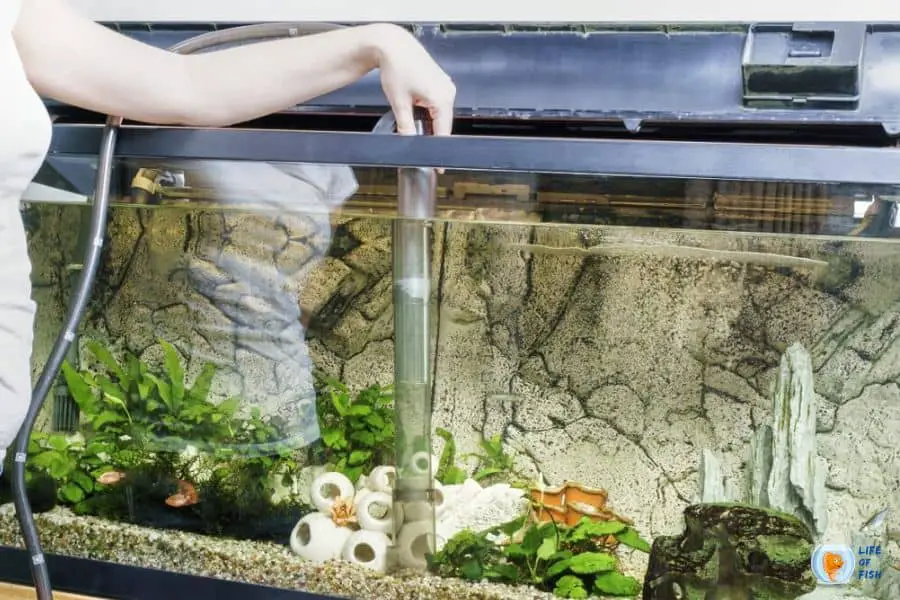Do your fish appear a little less energetic than usual? Maybe it is time to clean up their tank. You need regular maintenance to keep your fish healthy and content. We’ll discuss how to clean a fish tank in this article, as well as some tips for keeping the tank clean in the long run.
Keeping your fish’s aquarium clean is important for their health. Unclean water can cause a buildup of harmful chemicals and microbes that can lead to a variety of health issues. With routine cleaning and care, your fish can stay content and healthy.

This article will cover all aspects of cleaning a fish tank, from obtaining supplies to adding fresh fish and water. Along with answering some frequently asked questions, we’ll also provide some cleaning tips for fish tanks. Let’s move forward!
Steps to Clean a Fish Tank
Jump To
Now that you have all the necessary tools and supplies, it’s time to begin cleaning your fish tank. You should take the following actions:
- Turn off all electrical appliances: Before you start cleaning the tank, turn off any electrical appliances such as the heater, filter, and lights. You can prevent electric shock and keep the fish safe by unplugging these devices.
- Remove the fish: Carefully take the fish out of the tank using a fishnet, and then put them in a temporary container with some tank water. Your fish will stress and hurt if you take them out of the water for an extended period of time.
- To drain the water from the tank, gently pour it into a bucket. A large aquarium can have its water swiftly drained using a siphon hose. You should keep a small quantity of water at the bottom to safeguard the fish while you remove as much water as you can.
- You should take all decorations away, and artificial plants. Use a net or a gravel vacuum to remove any debris from the tank’s bottom. Also, you should rinse the gravel carefully in a pail of fresh water.
- Using a sponge or soft brush, carefully scrape the tank’s walls to clean it. Avoid using soap or detergent since they could endanger fish. Instead, you can use vinegar or a specialized fish-safe aquarium cleaner. Using clean water, thoroughly clean the tank.
- Pull the filter out of the tank and disassemble it to clean it. Use clean water to wash the sponge, the cartridges, and the other components. In the event of any damage, replace them right away.
- Fill up the tank: Put clean, dechlorinated water in the tank. Ensure that the water’s temperature is the same as it was before. To get rid of any chlorine, chloramine, or heavy metals from the water, use a water conditioner.
- After you fill the tank with water, place the decorations and gravel back in. Make sure they are clean before arranging them however you choose.
- Reconnect all of the electrical devices, then turn them on, including the heater, filter, and lights. Give the water at least 15 minutes to acclimatize to the new conditions before placing the fish back in the tank.
- Reintroducing the fish into the tank with caution is important. Let the fish a few minutes to adapt before releasing them. Observe the fish over the next few hours to make sure they are adjusting to their new surroundings.
Following these guidelines will help you keep your fish healthy and your tank clean. If you regularly clean up after your fish, they will thrive in their watery habitat.

Guidelines for Keeping a Clean Fish Tank
Regularly cleaning a fish tank is just one part of keeping one clean. You should conduct daily maintenance. By utilizing the following advice, you can keep your fish in good health and your tank tidy.
Alter the Water Often
One of the most important things you can do to maintain your fish tank clean is to perform regular water changes. How frequently you should change the water will depend on the size of your tank and the number of fish you have, but in general, it is recommended to change 10–20% of the water each week.
Before changing the water, use a siphon or a gravel vacuum to remove any waste or debris from the bottom of the tank. By doing this, you can keep the water clean and prevent the development of potentially harmful germs.
Keep an eye on the water’s pH.
The pH of the water plays a significant role in maintaining a healthy fish tank. Depending on the species you have, the pH range that the majority of freshwater fish prefer may change. Usually, it falls between 6.5 and 7.5.
To monitor the pH level of the water, you can use a test kit, which is available at most pet stores. To correct pH levels that are either too high or too low, you can introduce a pH adjuster.
Employ a Quality Filter
You need a good filter to keep a fish tank clean. The filter can aid in preventing the growth of harmful microorganisms by eliminating debris and trash from the water.
There are several different types of filters, including sponge filters, canister filters, and hang-on-back filters. Be sure the filter you choose is appropriate for the volume of fish you have and the size of your aquarium.
Avoid overfeeding your fish.
If you overfeed your fish, the ecology around them may suffer as a result of waste accumulation in the tank. To avoid overfeeding, give your fish little amounts of food two to three times per day.
To prevent food from rotting and contaminating the water after feeding, it’s essential to remove any uneaten food from the tank..
Stock the tank sparingly.
If you keep the tank only partially filled, it will be easier to keep it clean for your fish. The volume of waste in the tank will be reduced as a result. Keep the number of fish in each gallon of water to no more than one inch, according to common wisdom.
Avoid Filling the Tank Too Full
Overcrowding the tank may additionally lead to a buildup of trash and trouble keeping the area clean. Ensure sure the number and size of fish in your tank are appropriate for the tank’s size.
By following the suggestions in this manual, you can maintain the cleanliness of your fish tank and give your fish a healthy environment in which to thrive. Keep in mind to regularly clean the tank and check the water’s quality to maintain your fish happy and healthy.
Conclusion
Although keeping a fish tank clean and well-maintained may seem like a challenging task, it is crucial for the welfare of your fish. By following the guidelines in this article and putting the tips and tricks into practice, you can make sure that your fish tank remains a healthy and happy home for them. Remember to regularly clean your tank, check the pH level, check the filter, and check the stocking density. With a little care and upkeep, you can enjoy your wonderful fish and their vibrant colors for many years to come.

Recently asked question
How often should you clean a fish tank?
A number of factors affect how frequently you need to clean the tank. Such as the size, number, and kind of filtration system of a fish tank. A weekly partial water change of 10–20% of the total water volume is enough as a general guideline. However, if the tank is fully packed, it can need cleaning more frequently. To maintain the quality of the water, routine maintenance chores like filter cleaning and debris removal should be performed frequently.
Should I remove fish when cleaning tank?
Fish should typically be taken out of the tank while cleaning it. This lowers the possibility of damaging or stressing out the fish and makes it simpler to clean without bothering them. It might not be necessary to remove the fish, though, if you’re only performing a fast clean-up or water change and you’re confident you won’t injure the fish.
How do I keep my fish tank clean naturally?
- A fish tank can be kept clean naturally in a number of ways, including:
- Utilize living plants to keep the quality of the water upheld by plants’ ability to absorb nutrients from the water.
- Increase the number of good bacteria in the water to help minimize dangerous pollutants and break down waste. They can be added using either commercially available items or a substrate that promotes bacterial growth.
- Avoid overfeeding; this practice results in waste and uneaten food that might impair the quality of the water.
- Employ a siphon to regularly remove waste and uneaten food from the gravel or substrate.
- Avoid using cleaning products or chemicals that can hurt the fish or disturb the ecosystem’s equilibrium in the aquarium.
What is the safest way to clean a fish tank?
These steps are the safest ones to use while cleaning a fish tank:
- All electrical equipment, including heaters, filters, and lights, should be turned off before cleaning.
- Fish should be removed and put in a different container, if at all possible.
- Drain the water – Don’t damage the gravel or substrate by removing more than 10 to 20 percent of the water.
- A soft brush or sponge should be used to clean any ornaments, and aquarium-safe glass cleaner should be used to clean the glass.
- Replace the water in the tank with new, dechlorinated water.
- Equipment should be turned on when the tank has been refilled. After this, wait a short while before reintroducing the fish.
You may safely clean your fish tank and guarantee the health and welfare of your fish by following these instructions.
Read Next : Too Many Decorations In A Fish Tank : Deadly Consequences of Over-Decorating

